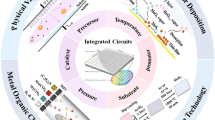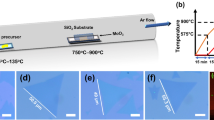Abstract
Lanthanum oxide (La2O3) nanostructured films are synthesized on a p-type silicon wafer by ablation of La2O3 pellet due to interaction with hot dense argon plasmas in a modified dense plasma focus (DPF) device. The nanostructured films are investigated using scanning electron microscopy (SEM), atomic force microscopy (AFM), and X-ray diffraction (XRD) spectra. SEM study shows the formation of nano-films having nano-size structures with the average nanostructures size ~25, ~53, and ~45 nm for one, two, and three DPF shots, respectively. The nanostructures sizes and morphology of nano-films are consistent between the AFM and SEM analyses. XRD spectra confirms nano-sized La2O3 with an average grain size ~34, ~51, and ~42 nm for one, two, and three DPF shots, respectively. The electrical properties such as current–voltage and capacitance–voltage (C–V) characteristics of the Al–La2O3–Si metal–oxide–semiconductor (MOS) capacitor structure are measured. The current conduction mechanism of the MOS capacitors is also demonstrated. The C–V characteristics are further used to obtain the electrical parameters such as the dielectric constant, oxide thickness, flat-band capacitance, and flat-band voltage of the MOS capacitors. These measurements demonstrate significantly lower leakage currents without any commonly used annealing or doping, thereby revealing a significant improvement of the MOS nanoelectronic device performance due to the incorporation of the DPF-produced La2O3 nano-films.










Similar content being viewed by others
References
Wong H, Iwai H (2006) On the scaling issues and high-κ replacement of ultrathin gate dielectrics for nanoscale MOS transistors. Microelectron Eng 83:1867–1904
Sun CQ (2003) Oxidation electronics: bond–band–barrier correlation and its applications. Prog Mater Sci 48:521–685
Kish LB (2004) Moore’s law and the energy requirement of computing versus performance. IEE Proc Circuits Devices Syst 151:190–194
Shauly EN (2012) CMOS leakage and power reduction in transistors and circuits: process and layout considerations. J Low Power Electron Appl 2:1–29
Kamata Y (2008) High-κ/Ge MOSFETs for future nanoelectronics. Mater Today 11:30–38
Han JW, Meyyappan M (2011) Copper oxide transistor on copper wire for e-textile. Appl Phys Lett 98:192102-1–192102-3
Filipic G, Cvelbar U (2012) Copper oxide nanowires: a review of growth. Nanotechnology 23:194001-1–194001-16
Lee BH, Kang L, Nieh R, Qi W-J, Lee JC (2000) Thermal stability and electrical characteristics of ultrathin hafnium oxide gate dielectric reoxidized with rapid thermal annealing. Appl Phys Lett 76:1926–1928
Ngai T, Qi WJ, Sharma R, Fretwell J, Chen X, Lee JC, Banerjee S (2000) Electrical properties of ZrO2 gate dielectric on SiGe. Appl Phys Lett 76:502–504
Alers GB, Werder DJ, Chabal Y, Lu HC, Gusev EP, Garfunkel E, Gustafsson T, Urdahl RS (1998) Intermixing at the tantalum oxide/silicon interface in gate dielectric structures. Appl Phys Lett 73:1517–1519
Blasco X, Porti M, Nafria M, Aymerich X, Petry J, Vandervorst W (2005) Electrical characterization of high-dielectric-constant/SiO2 metal–oxide–semiconductor gate stacks by a conductive atomic force microscope. Nanotechnology 16:1506–1511
Chakraborty G, Sarkar CK, Lu XB, Dai JY (2008) Study of the tunnelling initiated leakage current through the carbon nanotube embedded gate oxide in metal oxide semiconductor structures. Nanotechnology 19:255401-1–255401-7
Ramirez JM, Lupi FF, Jambois O, Berencen Y, Navarro-Urrios D, Anopchenko A, Marconi A, Prtljaga N, Tengattini A, Pavesi L, Colonna JP, Fedeli JM, Garrido B (2012) Erbium emission in MOS light emitting devices: from energy transfer to direct impact excitation. Nanotechnology 23:125203-1–125203-8
He G, Sun ZQ, Ma YQ, Wu MZ, Liu YM, Shi SW, Li G, Chen XS, Zhang LD, Fang ZB (2011) Composition dependence of interface control and optimization on the performance of an HfTiON gate dielectric metal–oxide–semiconductor capacitor. Semicond Sci Technol 26:105019-1–105019-8
Capodieci V, Wiest F, Sulima T, Schulze J, Eisele I (2005) Examination and evaluation of La2O3 as gate dielectric for sub-100 nm CMOS and DRAM technology. Microelectron Reliab 45:937–940
Jo SJ, Ha JS, Park NK, Kang DK, Kim B-H (2006) 5 nm thick lanthanum oxide thin films grown on Si (100) by atomic layer deposition: the effect of post-annealing on the electrical properties. Thin Solid Films 513:253–257
Zade D, Sato S, Kakushima K, Srivastava A, Ahmet P, Tsutsui K, Nishiyama A, Sugii N, Natori K, Hattori T, Sarkar CK, Iwai H (2011) Effects of La2O3 incorporation in HfO2 gated nMOSFETs on low-frequency noise. Microelectron Reliab 51:746–750
Mamatrishat M, Kubota T, Seki T, Kakushima K, Ahmet P, Tsutsui K, Kataoka Y, Nishiyama A, Sugii N, Natori K, Hattori T, Iwai H (2012) Oxide and interface trap densities estimation in ultrathin W/La2O3/Si MOS capacitors. Microelectron Reliab 52:1039–1042
Pisecny P, Husekova K, Frohlich K, Harmatha L, Soltys J, Machajdik D, Espinos JP, Jergel M, Jakabovic J (2004) Growth of lanthanum oxide films for application as a gate dielectric in CMOS technology. Mater Sci Semicond Process 7:231–236
Chiu F-C, Chou H-W, Lee JY-M (2005) Electrical conduction mechanisms of metal/La2O3/Si structure. J Appl Phys 97:103503-1–103503-5
Anders A (ed) (2000) Handbook of plasma immersion ion implantation and deposition. Wiley, New York
Anders A (2002) From plasma immersion ion implantation to deposition: a historical perspective on principles and trends. Surf Coat Technol 156:3–12
Pelletier J, Anders A (2005) Plasma-based ion implantation and deposition: a review of physics, technology, and applications. IEEE Trans Plasma Sci 33:1944–1959
Rawat RS (2012) High energy density pulsed plasmas in plasma focus: novel plasma processing tool for nanophase hard magnetic material synthesis. Nanosci Nanotechnol Lett A 4:251–274
Malhotra Y, Roy S, Srivastava MP, Kant CR, Ostrikov K (2009) Extremely non-equilibrium synthesis of luminescent zinc oxide nanoparticles through energetic ion condensation in a dense plasma focus device. J Phys D 42:155202-1–155202-7
Mangla O, Srivastava MP (2013) GaN nanostructures by hot dense and extremely non-equilibrium plasma and their characterizations. J Mater Sci 48:304–310. doi:10.1007/s10853-012-6746-y
Srivastava A, Nahar RK, Sarkar CK, Singh WP, Malhotra Y (2011) Study of hafnium oxide deposited using dense plasma focus machine for film structure and electrical properties as a MOS device. Microelectron Reliab 51:751–755
Ostrikov K, Neyts EC, Meyyappan M (2013) Plasma nanoscience: from nano-solids in plasmas to nano-plasmas in solids. Adv Phys 62:113–224
Mather JW (1964) Investigation of the high energy acceleration mode in the coaxial gun. Phys Fluids 7:S28–S34
Rawat RS, Srivastava MP, Tandon S, Mansingh A (1993) Crystallization of an amorphous lead zirconate titanate thin film with a dense-plasma-focus device. Phys Rev B 47:4858–4862
International Technology Roadmap for Semiconductors (2011), Semiconductor Industry Association
Ostrikov K, Levchenko I, Cvelbar U, Sunkara M, Mozetic M (2010) From nucleation to nanowires: a single-step process in reactive plasmas. Nanoscale 2:2012–2027
Soh LY, Lee P, Shuyan X, Lee S, Rawat RS (2004) Shadowgraphic studies of DLC film deposition process in dense plasma focus device. IEEE Trans Plasma Sci 32:448–455
Horcas I, Fernández R, Gómez-Rodríguez JM, Colchero J, Gómez-Herrero J, Baro AM (2007) WSXM: a software for scanning probe microscopy and a tool for nanotechnology. Rev Sci Instrum 78:013705-1–013705-8
Jun J-H, Wang C-H, Won D-J, Choi DJ (2002) Structural and electrical properties of a La2O3 thin film as a gate dielectric. J Korean Phys Soc 41:998–1002
Jun J-H, Choi DJ, Kim KH, Oh KY, Hwang CJ (2003) Effect of structural properties on electrical properties of lanthanum oxide thin film as a gate dielectric. Jpn J Appl Phys 42:3519–3522
Wu YH, Yang MY, Chin A, Chen WJ, Kwei CM (2000) Electrical characteristics of high quality La2O3 gate dielectric with equivalent oxide thickness of 5 Ǻ. IEEE Elect Device Lett 21:341–343
Wong H, Yang BL, Kakushima K, Ahmet P, Iwai H (2012) Effects of aluminium doping on lanthanum oxide gate dielectric films. Vacuum 86:929–932
Sze SM (1981) Physics of semiconductor devices, 2nd edn. Wiley, New York
Chang IY-K, Lee JY-M (2008) Temperature dependence of the current conduction mechanisms in LaAlO3 thin films. Appl Phys Lett 93:223503-1–223503-3
Acknowledgements
One of the authors (OM) is thankful to the Council of Scientific and Industrial Research (CSIR), New Delhi, India for financial assistance in term of award of Senior Research Fellowship (NET). The authors would like to thank Prof. M. P. Srivastava, Physics Department, Delhi University for experimental support to deposit La2O3 gate dielectric using dense plasma focus device. The authors would also like to thank Prof. V. R. Rao, Electrical Engineering Department, Indian Institute of Technology, Bombay, for useful comments, suggestion, and experimental support to do electrical characterization under the INUP Project. This work was also partially supported by the Australian Research Council and CSIRO’s OCE Science Leadership Scheme.
Author information
Authors and Affiliations
Corresponding author
Rights and permissions
About this article
Cite this article
Mangla, O., Srivastava, A., Malhotra, Y. et al. Lanthanum oxide nanostructured films synthesized using hot dense and extremely non-equilibrium plasma for nanoelectronic device applications. J Mater Sci 49, 1594–1605 (2014). https://doi.org/10.1007/s10853-013-7842-3
Received:
Accepted:
Published:
Issue Date:
DOI: https://doi.org/10.1007/s10853-013-7842-3




